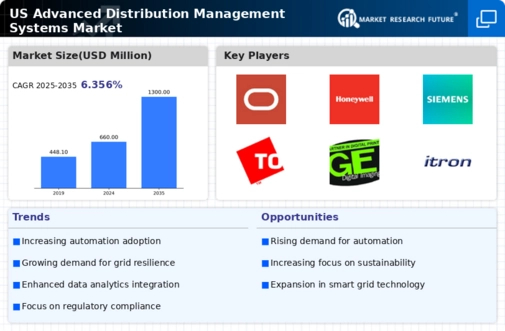Regulatory Compliance and Standards
Regulatory compliance is becoming a critical driver for the advanced distribution-management-systems market. As industries face stricter regulations regarding safety, environmental impact, and data security, companies are compelled to adopt systems that ensure compliance. For example, the implementation of advanced distribution-management systems can facilitate adherence to regulations by providing accurate tracking and reporting capabilities. This is particularly relevant in sectors such as pharmaceuticals and food distribution, where compliance is paramount. The need to meet these regulatory standards is likely to stimulate growth in the advanced distribution-management-systems market as organizations seek solutions that mitigate compliance risks.
Increased Focus on Customer Experience
The advanced distribution-management-systems market is increasingly influenced by the growing emphasis on customer experience. Businesses are recognizing that efficient distribution directly impacts customer satisfaction and loyalty. With consumers expecting faster delivery times and greater transparency in order tracking, companies are compelled to adopt advanced distribution-management systems that can meet these demands. Research indicates that organizations that enhance their distribution capabilities can see customer satisfaction scores improve by up to 25%. This focus on customer-centric distribution strategies is likely to drive further investment in advanced systems, thereby propelling the market forward.
Technological Advancements in Automation
Technological advancements are playing a pivotal role in shaping the advanced distribution-management-systems market. Automation technologies, including robotics and machine learning, are being integrated into distribution processes to enhance efficiency and accuracy. For instance, automated inventory management systems can reduce human error and improve stock accuracy by as much as 30%. This shift towards automation not only streamlines operations but also allows companies to respond more swiftly to market demands. As organizations continue to invest in these technologies, the advanced distribution-management-systems market is poised for significant growth, reflecting a broader trend towards digital transformation in supply chain management.
Rising Demand for Supply Chain Efficiency
The advanced distribution-management-systems market is experiencing a notable surge in demand driven by the need for enhanced supply chain efficiency. Companies are increasingly recognizing the importance of optimizing their distribution processes to reduce operational costs and improve service levels. According to recent data, organizations that implement advanced distribution-management systems can achieve up to a 20% reduction in logistics costs. This trend is particularly pronounced in sectors such as retail and manufacturing, where timely delivery and inventory management are critical. As businesses strive to remain competitive, the adoption of these systems is likely to accelerate, indicating a robust growth trajectory for the advanced distribution-management-systems market.
Growth of E-commerce and Omnichannel Strategies
The rapid growth of e-commerce is significantly impacting the advanced distribution-management-systems market. As online shopping continues to expand, businesses are increasingly adopting omnichannel strategies to meet consumer expectations for seamless shopping experiences. This shift necessitates sophisticated distribution-management systems capable of handling complex logistics and inventory across multiple channels. Data suggests that companies with effective omnichannel distribution strategies can achieve sales growth of up to 30%. Consequently, the demand for advanced distribution-management systems is likely to rise as businesses seek to enhance their capabilities in this evolving retail landscape.

















Leave a Comment